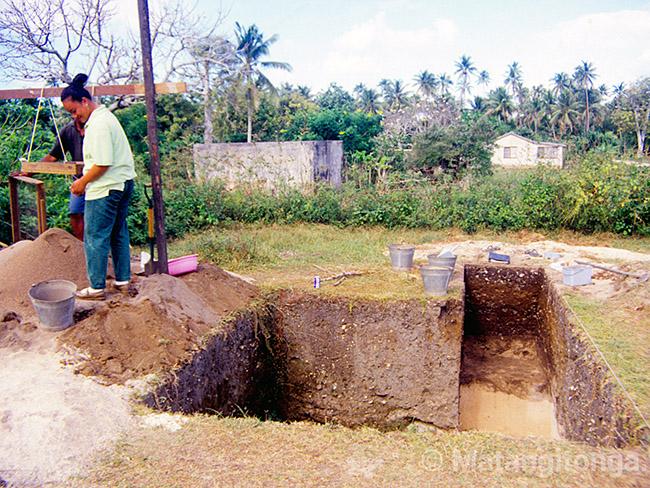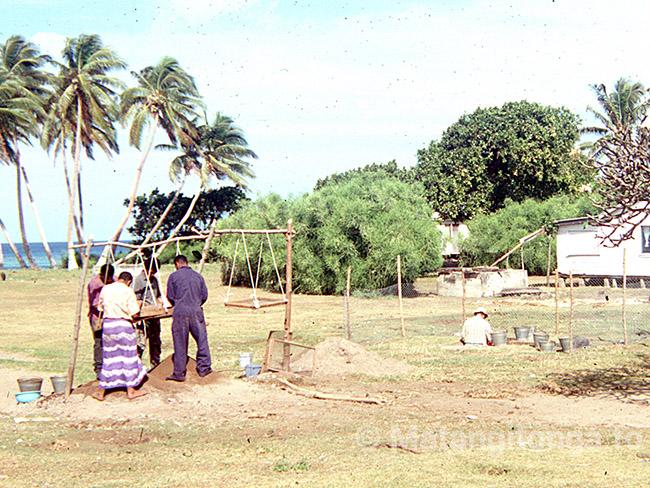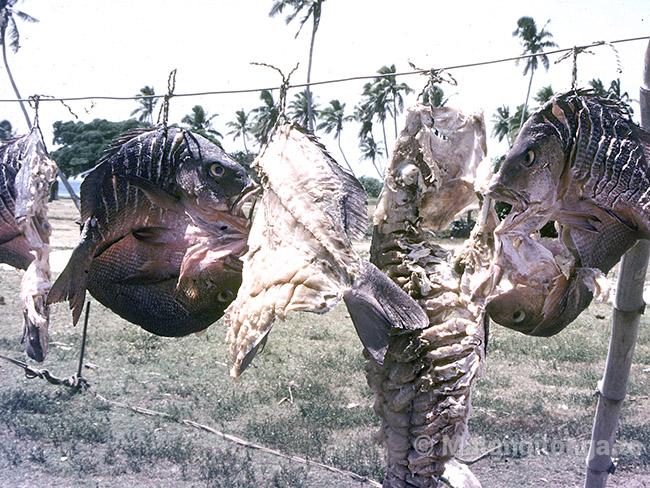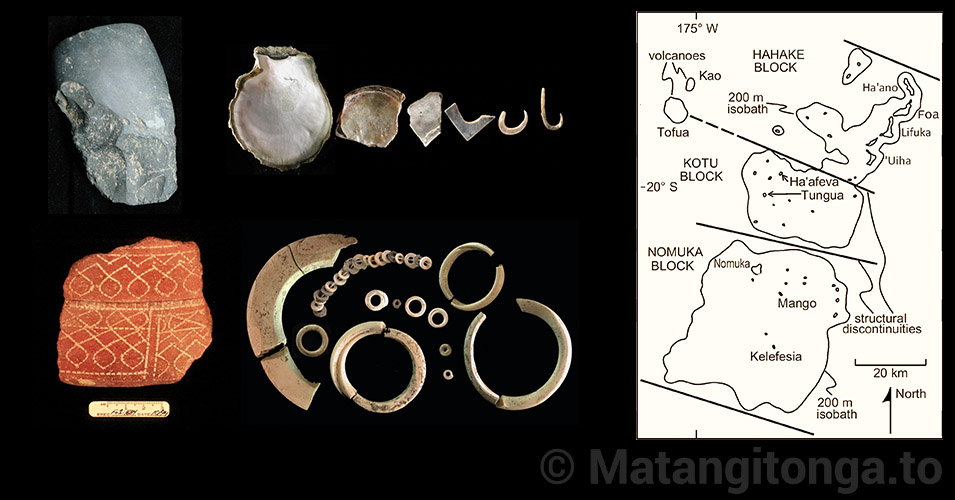

By David Burley
In the beginning, as legend has it, Ha’apai was a single land mass, one centred between Tongatapu in the south and Vava’u in the north. The great demigod Maui became angry with the gods and people of Ha’apai for reasons unclear. To vent that anger, he climbed to the high ground of ‘Eua near Tongatapu, and began throwing rocks at Ha’apai. His aim was true, breaking it into the widely dispersed islands that exist today. The Ha’apai group incorporates 51 islands scattered over a south to north distance of 100 km. These are small coral limestone islands and sand cays with most having their highest elevation no more than 15 m above sea level. The two exceptions, Kao and Tofua, are towering volcanoes that define the group’s western extent.
My first archaeological project in Tonga was in Ha’apai in 1989, that study having little to do with initial settlement of these islands. The early settlers, though, had left a distinctive footprint on the Ha’apai landscape that was impossible to ignore. Scatters of ancient pottery fragments associated with shell fish refuse and other artifacts were abundant on most of the islands I set foot upon. The oldest sites, those with decorated Lapita ceramics, are now documented on the islands of Ha’ano, Foa, Lifuka, ‘Uiha, Ha’afeva and Tungua. Excavations at these locales have provided insight into the timing and nature of colonization, and the impact these colonizers had on the islands they came to settle.
Notwithstanding the ancient traditions of Maui, Ha’apai geology is complex, and the search for Lapita settlements in the islands was not a straight forward nor easy process. Higher (ancient) sea levels, as described in an earlier article for Tongatapu, is one of the complicating factors. But even more perplexing are geological faults that crosscut Tonga along its length. These rifts create structural blocks that, much like piano keys, move up or down independently, admittedly at a very slow pace. The long-term affect can be consequential. At ‘Uiha, an island on the uplifting Hahake block, the Lapita site occurs in the api uta inland of ‘Uiha village, a distance of 500 metres from the current shore. At Hafeva on the Kotu block, the equivalent aged site is close to the shore at a buried elevation slightly below sea level today. The Kotu block has submerged by more than 1.4 metres, keeping it roughly in tandem with sea level fall over the past 3000 years.
Radiocarbon and uranium thorium dates confidently position first settlement in Ha’apai between 825 and 810 BC. This occurred three generations (75 years) after the first Lapita canoes arrived at Fanga ‘Uta Lagoon on Tongatapu. The dates for individual Lapita sites are informative. They not only answer the question of when, but they reflect upon the process by which the expansion was undertaken. Within Ha’apai, there is no one site that is earlier than the rest with settlement origins closely overlapping in age. At the same time, these sites are small, with estimated populations of two to three families at the most. Simultaneous settlement, widely dispersed hamlets on different islands, and small groups of people clearly speak to a planned and organized strategy. In its creation of a settlement network northward from Tongatapu, it brilliantly laid title to these islands.
When Lapita settlements in Ha’apai are compared in their original context, there is a remarkable similarity. Each was situated on a sandy back beach, not on the elevated agricultural soils occurring inland of the shore. Each is on the leeward coast facing a fringing reef, but where a reef break allowed access to navigable waters. Each is characterized as a kitchen midden where shell fish, fish and other bone refuse, ceramics and the like are incorporated within a matrix of organically rich sediment. Each includes adzes, pounders and umu rock from Tofua, illustrating repeated visits to the volcano. And each has a continuous occupation from the earliest Lapita settlers through the millennia into the contemporary villages of Pukotala, Faleloa, Tongoleleka, ‘Uiha, Kolongatata and Tungua.
Excavations in Ha’apai were conducted through the mid-1990s with crews of five to six men from the villages in which we worked. I can only imagine what people must have thought when an unexpected pālangi arrived in the village and asked the ‘ofisi kolo for permission to dig a hole in its midst. Yet as the excavations proceeded downward, our crew and the various onlookers began to recognize artifacts and features that had surprising familiarity. Not the least were the decorated ceramics from the lowest levels of the site. Aspects of ngatu patterns today have their origins in Lapita design motifs, an observation that was readily apparent. Each of the site excavations in Ha’apai had multiple stories to tell, some quite specific, others of a broader nature. A favorite of mine, as labelled in my field notes, was the “first picnic”. This was a dense concentration of sea turtle, extinct megapode (malau) and extinct iguana (moko) bone buried 2.2 m down in swirled beach sand at the bottom of the Tongoleleka site. These were the leftovers and rubbish of a veritable buffet, ancient remnants from one of Ha’apai’s very first feasts.
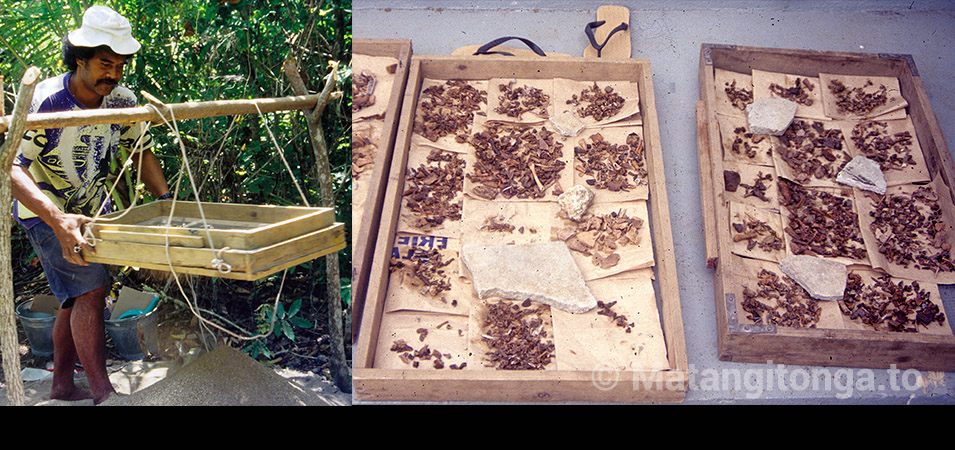
Large volumes of bone were a characteristic of the Ha’apai excavations, a collection that has taken years to identify and analyse. The vast majority are reef fish with groupers (ngatala), parrot fish (homohomo), emperor fish (koango) and surgeon fish (palangi) definitely preferred. Turtle bone in the earliest occupations is substantially abundant, but where its frequency drops off sharply immediately thereafter.
The iguana of the first picnic was also distributed widely in sites throughout Ha’apai. This species was almost twice the size of the one currently present in Fiji, measuring up to 1.5 m long from snout to tip of tail. With no predators or defense mechanisms when people first arrived, its fate was predetermined. The land birds in our collections include pigeons (lupe), fruit doves (kulukulu), parrots (koki), rails (veka), flightless megapodes and others, often with multiple species being recovered. This assemblage lucidly illustrates the impacts of first human arrival.
On Lifuka in 1997 there were ten species of land birds recorded for the island. From the Lapita site at Tongoleleka, a minimum of 24 species is incorporated within the collection. Even on the miniscule (1.3 square kilometres) island of Ha’afeva to the south, no less than 21 species were excavated in similar age deposits. Not all species went extinct, but several did, and several others no longer exist in Tonga today.
We have defined the earliest sites in Tonga by the presence of decorated Lapita ceramics. When decorated ceramics no longer were produced, the Lapita era came to an end. It is replaced in Tongan culture history by the Polynesian Plainware period where ceramics, as the name implies, went unadorned. This break acutely marks the transition from a settlement phase to a phase of settling in, where populations grew substantially and where settlement expansion was widespread. The end of Lapita ceramics came quickly in Ha’apai, defined within the temporal interval 780 to 760 BC. Why potters stopped decorating their pots is a question without answer. It is an archaeological puzzle matched only by the disappearance of pottery altogether some 350 to 400 years later.
Dr. David V. Burley is a Professor of Archaeology at Simon Fraser University in Burnaby, BC, Canada. He has carried out archaeological studies in Tonga since 1989.


